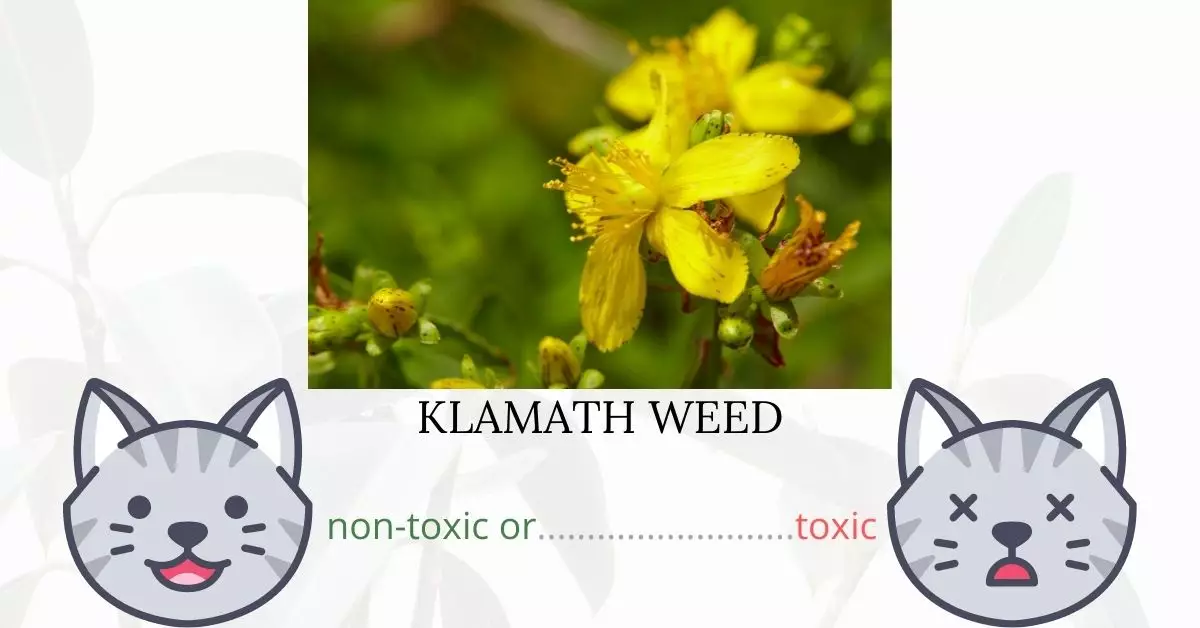Klamath weed, also commonly known as St. John’s Wort, is indeed harmful to cats due to the presence of hypericin, a compound known to cause photosensitivity, increased heart rate, and skin ulcers when ingested. Exposure to this plant can lead to severe reactions such as sunburns, blisters, and, potentially, skin cancer in felines. Although rarely fatal, it is crucial for the well-being of the pet to secure prompt veterinary intervention if ingestion or exposure is suspected.
This article is the culmination of collaborative efforts with a team of experienced Doctors of Veterinary Medicine (DVMs), ensuring the delivery of precise and current information regarding the dangers posed by various plants, like Klamath Weed, to cats. The insights and knowledge shared here are reflective of extensive research and consultation with high-authority veterinary and pet care websites including ASPCA and PetMD, aimed at unraveling the intricate aspects of plant toxicity and their impacts on feline health. Our collective endeavor is to provide reliable guidance on the potential risks associated with Klamath weed, and its counterparts, to help cat owners make informed decisions about their pet’s safety and health.
Clinical Signs of Klamath Weed or St. John’s Wort Poisoning in Cats
When cats come into contact with, inhale the fragrance of, or consume Klamath weed, or St. John’s Wort, they may exhibit several clinical signs due to the presence of hypericin in the plant, a compound known to be toxic to them. The manifestation of symptoms may vary among individual cats; some may not display any adverse effects post-ingestion, while others can experience severe reactions. Here’s a detailed look at each sign and the reasons behind their occurrence:
- Photosensitization: Hypericin induces photosensitivity, making cats excessively vulnerable to light, especially sunlight. This heightened sensitivity can lead to severe sunburns, increasing the risk of blisters and potential skin cancers due to prolonged exposure to sunlight.
- Skin Ulcers: The toxic compound in Klamath weed causes ulcerations on the cat’s skin. These painful, open sores are a direct result of the internal irritation and inflammation caused by the ingestion of the plant.
- Blisters: These are secondary to photosensitization. The heightened sensitivity to light causes the skin to react severely, forming painful blisters.
- Increased Temperature and Heart Rate: The ingestion of Klamath weed can lead to an elevated body temperature and heart rate due to the stimulatory effect of hypericin on the cat’s cardiovascular and thermoregulatory systems.
- Dermatitis: Dermatitis, or inflammation of the skin, can occur due to the cat’s adverse reaction to the toxic components of the plant, resulting in itchiness, redness, and swelling.
Understanding these clinical signs is crucial for cat owners, as early detection and intervention can prevent the condition from escalating, reducing the risk of long-term damage or complications. Immediate veterinary consultation and treatment are imperative if a cat is suspected of having been exposed to Klamath weed or St. John’s Wort.
First Aid and Treatment of Klamath Weed or St. John’s Wort Poisoning in Cats
The usual treatment for plant poisoning will be also done to cure your cat of Klamath weed poisoning. The veterinarian’s treatment may include administering activated charcoal, inducing vomit, intravenous fluid therapy, and performing gastric lavage. These procedures may be done depending on the veterinarian’s discretion.
If your cat’s skin has developed blisters or ulcers, the doctor will usually use topical treatments to ease itching and minimize swelling. In extreme circumstances, oral corticosteroids may be used.
Recovery from Klamath Weed or St. John’s Wort Poisoning in Cats
Klamath weed toxicity in cats is virtually always benign. Most cats will be returned to their owners after treatment, but if the cat is severely dehydrated as a result of the treatment, he may need to be watched at the veterinarian’s office.
Prevention of Klamath Weed or St. John’s Wort Poisoning in Cats
If Klamath weeds are present in your yards, remove them right away. Indoors is the safest place for your cats as you can keep an eye on them. To keep them indoors, engage them, and keep them mentally stimulated to prevent them from getting bored and start wandering away. Try planting cat-friendly plants as an alternative.
If you love plants but have cats at home, check out these lists:





